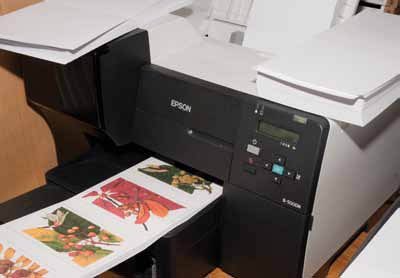articles/Printers/cardsharps-page1
Card Sharps - part 1 of 1 2 3 4 5 6 7
by Mike McNamee Published 01/02/2012

We touched, somewhat superficially,
upon the subject of card-making in a previous issue as part of fine art printing. The article generated a couple of enquiries and so we undertook to investigate further, check out the Epson WorkForce series of printers (along with the 'B' series) and explore the raw materials available for the job. This ultimately allowed us to create a costing spread-sheet as part of an analysis into the economics of the process. As things turned out there were a few surprises along the way, good, bad and sometimes plain confusing! We ended up switching our printer allegiance to the Epson B510, (which was actually the one we wanted to test at the outset, we were persuaded to the WP 4525).
Our knowledge of the costs of paper blanks, envelopes and sourcing stock was also vastly superior at the end of the process than at the start!
The Market
The market for cards is large, enough for there to be cardselling stands in most supermarkets and also specialist cards shops on many high streets. In addition cards are also sold at most galleries, gift shops, tourist shops and local newsagents.
One problem is that breaking into the larger sales outlets is difficult for a self-employed photographer; there is, however, a niche market which, as we will see, is not insignificant. In your deliberations you need to factor a mark-up of 100% for many outlets (200% for some). Most galleries will tell you that prints and pictures sold from tourist areas have to be local to that area. People who are on holiday browse in shops (especially in bad weather) and this often prompts them to buy both postcards to send immediately, but also slightly more up-market cards for birthdays and special occasions.
This is the buyer's opportunity to sell a quality card for those people in the buyer's circle who do not qualify for an actual present but for whom a quality card adds a little touch of 'specialness', perhaps a greeting card and postcard rolled into one.
This suggests then that there is a premium, niche market for quality cards. The main requirements seem to be: 1. Sell from an outlet where people browse (tourist shops, art galleries, gift shops, garden centres, tourist traps).
2. Try to make the card local, otherwise you are competing with mass-produced cards.
3. Try to ensure that there is a premium tag associated with the card to lift it above the mass-produced offering along the shelf.
4. Make sure that the card complies with postal regulations for standard class posting (or make it clear that it is not!).
In addition to card selling there are other opportunities such as printing cards for your wedding clients, printing cards for local artists or simply sending cards from your own business to keep in touch with your client base (birthdays, anniversaries and the like, which should be part of your business database).
In this last case, if you send a quality card it is less likely to be discarded if it is local, even less so if it contains an image of the client themselves. The retained card is free advertising space on the desk, pin-board or other area, for the duration of its stay. The ultimate prize is for the card to be so valued that it is framed. At the last count, McNamee Towers has 10 cards on the walls or pin boards, six of which are framed - this is probably not unusual. And talking of advertising yourself, if you make a cards of your own images, don't forget to add to the back of the print something like: "This card is made with fade resistant inks but also available as a 20x16 inch fine art, limited edition giclee print on museum grade media - visit www.artyprintsRus.com for more information".
In summary then the market opportunity lies in selling cards, making cards and a bit of self-marketing.
Now there is little point in making and selling cards at a loss (unless their 'marketing' value is extremely high) so you need to know, with some accuracy, what your production costs are. We will assume for the moment that you are concurrently making cards for yourself, making cards to sell and making cards for local artists. Even with all three on the go, the output is likely to be many hundreds, but not many thousands, of cards. Let's imagine a scenario and do some totals. Your client base might be: An artist or art gallery, say 200 cards each for five clients; say five local shops each holding 30-50 cards on stock, a total of 250 cards; you might send 100 cards at Christmas and another 50 for anniversaries; a wedding thank-you set might comprise 20 weddings each with 100 guests (but as partners, ie couples) so that is another 1,000 to the pile. In total then 2,500 cards is a credible number on which to base some calculations. Note that the mix also dictates that many cards will be different and batch sizes will be around 50 or so.
You are currently on page 1
- Card Sharps page 1
- Card Sharps page 2
- Card Sharps page 3
- Card Sharps page 4
- Card Sharps page 5
- Card Sharps page 6
- Card Sharps page 7
1st Published 01/02/2012
last update 09/12/2022 14:52:16
More Printers Articles
There are 0 days to get ready for The Society of Photographers Convention and Trade Show at The Novotel London West, Hammersmith ...
which starts on Wednesday 15th January 2025





